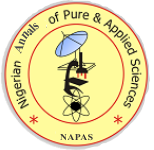Article Submission Guideline
General Information
The Nigerian Annals of Pure and Applied Sciences (NAPAS) is an independent journal of the Faculty of Science, Benue State University, Makurdi. The objective of the Journal is to encourage publication and dissemination of research findings within the academic community and the general society. NAPAS vision is to be the foremost avenue for the dissemination of research findings in Northern Nigeria. To ensure and maintain the culture of academic excellence, the Editorial Board through specialized sub-editorial committees, reviews all submitted manuscripts, before they are sent to external reviewers. The Editorial Board and Editorial Advisory Board members are distinguished academicians drawn from various Nigerian Universities.
The scope of the Journal
NAPAS is a bi-annual publication established for the purpose of publishing original research works not published or being considered for publication in another Journal. NAPAS will publish researches in all aspects of pure and applied sciences, including Biology, Chemistry, Physics, Biochemistry, Mathematics, Computer science, Engineering, Geography, Medicine, Geology, Environmental Sciences, Public Health, Parasitology, Entomology, Botany, Zoology and all related fields in the sciences.
Submission of articles for publication
Articles should be submitted to the Editor-in-Chief, either online here or as an email attachment to eddieomudu@yahoo.com
Style and Format
The manuscript should not exceed 15 pages including tables and figures. Authors are advised to use New Times Romans and font size 12. S.I. units and metric systems of measurement are acceptable and Latin and scientific words should be in italics.
Manuscripts should follow the following order:
1. Title
2. Name(s) of Author(s)
3. Address of Author(s)
4. Abstract in approximately 250 words
5. Introduction
6. Materials and Methods
7. Results
8. Tables, Figures, Plates etc
9. Discussions
10. Acknowledgments
11. References
(Authors should please comply strictly to this format)
Title page
The title of the paper should unambiguously reflect the contents and the main theme of the paper. The title should not exceed 18 words except when it is absolutely unavoidable. The full names and addresses of the authors (including names of Institutions and Country) should be stated. In case of multiple authorship, the name and mailing address of the author to whom further correspondents would be referred should be indicated. Author’s name should start with surname first then other names in full.
Abstract
An abstract of a single paragraph, of not more than 250 words should be provided. This should give the purpose/objectives of the study, the procedure or methodology, key findings and conclusion of the research work. The abstract should be followed by the keywords index of not more than five words.
Introduction
This should contain essential background information and important relevant references. The objective of the work and its relevance or contribution must be clearly stated. Literature cited must be discussed to show the relationship between the published work and the research study. The Introduction should provide a clear statement of the problem, the relevant literature on the subject, and the proposed approach or solution. It should be understandable to colleagues from a broad range of scientific disciplines.
Materials and Methods
New methods and modifications of established ones should be described in detail to enable repetition by other workers. For established and published methods, references should be made to the relevant publications. Generally, acceptable scientific terms should be used. Discuss the factors, problems encountered and the solutions as they apply to your study. Due attention should be given to experimental design, biochemical analysis and statistics.
Results
Results should be presented with clarity and precision. The results should be written in the past tense when describing findings in the authors' experiments. Previously published findings should be written in the present tense. Results should be explained, but largely without referring to the literature. Discussion, speculation and detailed interpretation of data should not be included in the Results but should be put into the Discussion section.
Tables should be simple, scientific and editable with clear titles and legends where applicable. Tables should be numbered serially in Arabic numerals and should be self-explanatory without reference to the text.
Figure legends should be typed in numerical order on a separate sheet. Graphics should be prepared using applications capable of generating high-resolution GIF, TIFF, JPEG or Powerpoint before pasting in the Microsoft Word manuscript file. Use Arabic numerals to designate figures and upper case letters for their parts (Fig 1). Begin each legend with a title and include sufficient description so that the figure is understandable without reading the text of the manuscript. Information given in legends should not be repeated in the text.
Discussion
The Discussion should interpret the findings in view of the results obtained in this and in past studies on this topic. It should indicate clearly the significance and implications of the results obtained. State the conclusions in a few sentences at the end of the paper. The Results and Discussion sections can include subheadings, and when appropriate, both sections can be combined.
7. References
In the text, a reference identified by means of an author‘s name should be followed by the date of the reference in parentheses. When there are more than two authors, only the first author‘s name should be mentioned, followed by ’et al‘. In the event that an author cited has had two or more works published during the same year, the reference, both in the text and in the reference list, should be identified by a lower case letter like ’a‘ and ’b‘ after the date to distinguish the works. All cited works should be put after the text at the end of the paper. The references should be alphabetically ordered. References should follow this order: surname, initials of first and middle name, year of publication, title (of study), name of periodical, volume, issue, and pages. If the reference is a book, the place and name of the publishing agency should be mentioned.
Examples of citations are as follows:-
Citation from journals
Omudu, E. A. and Okafor, F. C. (2007). Rapid epidemiological and socio-cultural appraisal of lymphatic filariasis amongst the Igede ethnic group in Benue State, Nigeria. Nigeria Journal of Parasitology, 28; 118-124.
Adejo, S. O., Wuana, R. A., Leave, E. T. and Angba, O. M. (2008). Evaluation of physicochemical and adsorptive properties of adsorbent prepared from guinea corn (Sorghum bicolor) husk. Nigerian Journal of Pure and Applied Sciences, 1: 1-9.
Citation from an edited book
Pratt, H. D.and Smith, J. W. (1998). Arthropods of public health importance. In: diagnostic procedures for mycotic and parasitic infections Wentworth, B. B. (Ed.) American Public Health Association. Washington D.C. 20005, 179-192.
Citation from unpublished work
Tsor, J. O. (2003). Characteristics of aerosols in the atmosphere during the harmattan in three Nigerian cities. M.Sc Thesis. University of Jos, Jos, Nigeria. 118pp.
Processing/Publication charges
A Processing/Publication charge of thirteen thousand naira (N13,000.00) only or Forty (40) US Dollars, will be charged per manuscript on acceptance of the manuscript for publication. This is to be paid into the Nigerian Annals of Pure and Applied Sciences account in Guaranty Trust Bank.
Journal Account Details:
Journal Name: Nigerian Annals of Pure and Applied Sciences
Office Address: Editor In Chief, Department of Biological Sciences, Benue State University, Makurdi, Nigeria.
Bank Name: Guaranty Trust Bank, Makurdi, Nigeria
Account Number: 0028176469.
Swift Code: GTBINGLA
Subscription and Correspondence
All types of correspondence, including subscription, should be addressed to the editor.
e-mail: njpas1998@yahoo.com or eddieomudu@yahoo.com. Manuscripts could be submitted as an e-mail attachment.
Prof. Edward Omudu
Department of Biological Sciences
Benue State University
PMB 102119
Makurdi.


 Contact Us
Contact Us Editorial Team
Editorial Team Join As A Reviewer
Join As A Reviewer  Request For Print Copy
Request For Print Copy


 Cprint Publishers
Cprint Publishers